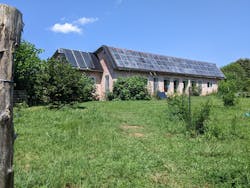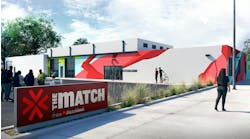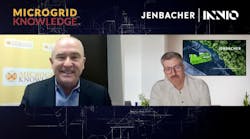Direct current (DC) microgrids are becoming more common and offer significant advantages over alternating current (AC) microgrids, their fans and developers say.
For example, the U.S. Air Force Research Laboratory (AFRL) recently awarded a $4.8 million contract to Concurrent Technologies Corporation (CTC) to develop and implement DC microgrid technologies on Kirtland Air Force Base (KAFB).
And Block Energy has developed a residential, plug-and-play DC microgrid system.
DC vs AC microgrids
In a DC building microgrid, DC is distributed throughout the building. DC building loads can be met directly from DC supplied by PV panels and energy storage batteries. That means there is no alternating current (AC)-to-DC or DC-to-AC conversion. As a microgrid, the building doesn’t rely on grid AC power and can disconnect from the grid and operate without it, even during outages, according to the U.S. Department of Energy.
"Direct current microgrids are inherently more efficient to dispatch and have higher stability for grid-forming operation, which is critical for non-wires alternative solutions," said Bobbi Dillow-Walsh, vice president, sales and commercial development, Block Energy. "The challenge is that integrating DC with the AC grid is a newer concept. But the two systems really complement one another."
The Living Energy Farm, located on 127 acres in rural Louisa County, Virginia, is powered by an off-grid “direct drive” DC microgrid. It’s a DC microgrid with a twist.
The system was created about 13 years ago. Alexis Zeigler, along with his wife, Debbie Piesen, established the farm, which has ten people living in the same house. Zeigler installed the microgrid system, which was 80% cheaper to build than traditional electricity systems in part because there are no inverters and few batteries. It also runs with little maintenance costs, he said.
Electricity goes directly from PV panels to DC motors
The farm’s secret: In the community, 87% of the electricity is used directly from photovoltaic (PV) panels to run DC motors.
It’s a flexible system, said Zeigler. The motors can speed up and slow down as the amount of available solar increases or decreases. This reduces or eliminates the need for batteries to store solar.
High-voltage DC motors do much of the work at the farm, powering the space and water heating systems, for example.
Thermal storage–not electric storage–at night
The system uses direct DC power during the day, when solar is available, and non-electric storage at night. For example, when a DC solar refrigerator isn't powered by solar, the food stores energy as thermal mass. When the refrigerator isn’t full, large jugs of water in it can help ensure the refrigerator stays cold.
The farm uses nickel-iron batteries to power lights, fans and electronics. This type of battery can last 50 years or more–longer than lithium-ion batteries, said Zeigler.
Last March, the farm’s off-grid system and technology–developed by Alexis, who is not an engineer– won honorable mention and a $5,000 prize from Empower a Billion Lives, a global engineering competition that aims to design energy solutions for the poorest 1 billion people on the planet.
Helping Puerto Rico with off-grid DC microgrids
Alexis now has set his sights on helping people all over the world take advantage of the system he developed. He has done some work on the Navajo and Hopi Reservations in the U.S., and one small project in Jamaica, but now is focused on Puerto Rico, where local organizations are eager to provide support, he said.
He also has his eye on developing off-grid condos in the U.S. powered by direct drive DC microgrids.
In January 2023, Zeigler and Piesen installed their system at three community centers and six residences in Puerto Rico as part of the final round of the Empower a Billion Lives competition, which was organized by the Institute of Electronic and Electrical Engineers. That project led to the honorable mention award from Empower a Billion Lives.
Next on Zeigler’s to-do list are off-grid condos in the U.S. Most families don’t want to share a house like the families residing on Living Energy Farm, who gain efficiency by sharing space and electricity.
Because condos are group living situations, their owners can acquire some of the efficiencies the farm experiences, said Zeigler.
Sharing spaces creates efficiencies
The condos could potentially be low-income housing in a city. It’s also possible the condos could be built on the Living Energy Farm, which has space, he said.
One challenge to promoting the idea of off-grid DC microgrids, said Zeigler: Most housing is built around the family unit. But with more than one family in each house, efficiencies and savings are gained with the DC microgrid.
“The model we have is a shared living room, kitchen and bathroom. Americans won’t do that,” Zeigler said. “But if we can give people more privacy, and share what we’ve learned, we can do fully off -grid condos that are a dramatic departure from any housing in terms of their environmental footprint,” he said.
Meanwhile, trying to convince U.S. families to share more than a few walls and utility services isn’t easy. The middle-income families would prefer Tesla Powerwalls to power their big-screen TVs and computers, he said.
Right now, Zeigler is looking for funding to build more off-grid DC microgrids in the U.S., Puerto Rico and potentially Sub Saharan Africa.
But at times, “it’s like selling tofu to meat eaters,” he said.








